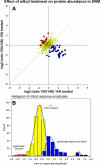Definition of Arabidopsis sterol-rich membrane microdomains by differential treatment with methyl-beta-cyclodextrin and quantitative proteomics
- PMID: 19036721
- PMCID: PMC2667346
- DOI: 10.1074/mcp.M800346-MCP200
Definition of Arabidopsis sterol-rich membrane microdomains by differential treatment with methyl-beta-cyclodextrin and quantitative proteomics
Abstract
Plasma membranes are dynamic compartments with key functions in solute transport, cell shape, and communication between cells and the environment. In mammalian cells and yeast, the plasma membrane has been shown to be compartmented into so-called lipid rafts, which are defined by their resistance to treatment with non-ionic detergents. In plants, the existence of lipid rafts has been postulated, but the precise composition of this membrane compartment is still under debate. Here we were able to experimentally clearly distinguish (i) true sterol-dependent "raft proteins" and (ii) sterol-independent "non-raft" proteins and co-purifying "contaminants" in plant detergent-resistant membranes. We used quantitative proteomics techniques involving (15)N metabolic labeling and specific disruption of sterol-rich membrane domains by methyl-beta-cyclodextrin. Among the sterol-dependent proteins we found an over-representation of glycosylphosphatidylinositol-anchored proteins. A large fraction of these proteins has functions in cell wall anchoring. We were able to distinguish constant and variable components of plant sterol-rich membrane microdomains based on their responsiveness to the drug methyl-beta-cyclodextrin. Predominantly proteins with signaling functions, such as receptor kinases, G-proteins, and calcium signaling proteins, were identified as variable members in plant lipid rafts, whereas cell wall-related proteins and specific proteins with unknown functions make up a core set of sterol-dependent plant plasma membrane proteins. This allows the plant to maintain a balance between static anchoring of cell shape forming elements and variable adjustment to changing external conditions.
Figures






Similar articles
-
Unraveling sterol-dependent membrane phenotypes by analysis of protein abundance-ratio distributions in different membrane fractions under biochemical and endogenous sterol depletion.Mol Cell Proteomics. 2013 Dec;12(12):3732-43. doi: 10.1074/mcp.M113.029447. Epub 2013 Sep 12. Mol Cell Proteomics. 2013. PMID: 24030099 Free PMC article.
-
Depletion of phytosterols from the plant plasma membrane provides evidence for disruption of lipid rafts.FASEB J. 2008 Nov;22(11):3980-91. doi: 10.1096/fj.08-111070. Epub 2008 Aug 1. FASEB J. 2008. PMID: 18676403
-
Metabolic labeling and membrane fractionation for comparative proteomic analysis of Arabidopsis thaliana suspension cell cultures.J Vis Exp. 2013 Sep 28;(79):e50535. doi: 10.3791/50535. J Vis Exp. 2013. PMID: 24121251 Free PMC article.
-
Membrane microdomains, rafts, and detergent-resistant membranes in plants and fungi.Annu Rev Plant Biol. 2013;64:501-29. doi: 10.1146/annurev-arplant-050312-120103. Annu Rev Plant Biol. 2013. PMID: 23638827 Review.
-
Lipid raft proteomics: more than just detergent-resistant membranes.Subcell Biochem. 2007;43:35-47. doi: 10.1007/978-1-4020-5943-8_4. Subcell Biochem. 2007. PMID: 17953390 Review.
Cited by
-
Methods of staining and visualization of sphingolipid enriched and non-enriched plasma membrane regions of Arabidopsis thaliana with fluorescent dyes and lipid analogues.Plant Methods. 2012 Aug 6;8(1):28. doi: 10.1186/1746-4811-8-28. Plant Methods. 2012. PMID: 22867517 Free PMC article.
-
Internalization of miPEP165a into Arabidopsis Roots Depends on Both Passive Diffusion and Endocytosis-Associated Processes.Int J Mol Sci. 2020 Mar 25;21(7):2266. doi: 10.3390/ijms21072266. Int J Mol Sci. 2020. PMID: 32218176 Free PMC article.
-
Detergent-resistant plasma membrane proteome to elucidate microdomain functions in plant cells.Front Plant Sci. 2013 Feb 22;4:27. doi: 10.3389/fpls.2013.00027. eCollection 2013. Front Plant Sci. 2013. PMID: 23440896 Free PMC article.
-
Membrane nanodomains and transport functions in plant.Plant Physiol. 2021 Dec 4;187(4):1839-1855. doi: 10.1093/plphys/kiab312. Plant Physiol. 2021. PMID: 35235669 Free PMC article. Review.
-
Quantitative proteomics reveals a dynamic association of proteins to detergent-resistant membranes upon elicitor signaling in tobacco.Mol Cell Proteomics. 2009 Sep;8(9):2186-98. doi: 10.1074/mcp.M900090-MCP200. Epub 2009 Jun 13. Mol Cell Proteomics. 2009. PMID: 19525550 Free PMC article.
References
-
- Simons, K., and Ikonen, E. ( 1997) Functional rafts in cell membranes. Nature 387, 569–5672 - PubMed
-
- Brown, D. A., and London, E. ( 2000) Structure and function of sphingolipid- and cholesterol-rich membrane rafts. J. Biol. Chem. 275, 17221–17224 - PubMed
-
- Simons, K., and Toomre, D. ( 2000) Lipid rafts and signal transduction. Nat. Rev. Mol. Cell Biol. 1, 31–39 - PubMed
Publication types
MeSH terms
Substances
LinkOut - more resources
Full Text Sources

